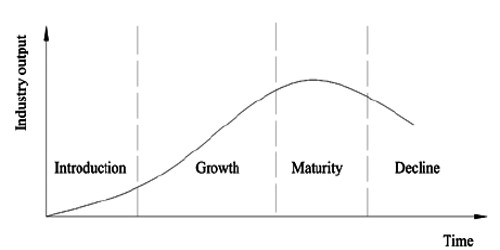Industry life cycle
An industry is a classification that refers to a group of companies that are related in terms of their primary business activities. A concept relating to the different stages an industry will go through, from the first product entry to its eventual decline. Industries are born when new products are developed, with considerable uncertainty regarding market size, product specifications, and key competitors. There are typically five stages in the industry lifecycle. They are defined as:
- Early Stages Phase – Alternative product design and positioning, establishing the range and boundaries of the industry itself. Consumers in the new industry have come to understand the value of the new offering, and demand grows rapidly.
- Innovation Phase – Product innovation declines, process innovation begins and a “dominant design” will arrive.
- Cost or Shakeout Phase – Companies settle on the “dominant design”; economies of scale are achieved, forcing smaller players to be acquired or exit altogether. Barriers to entry become very high, as large-scale consolidation occurs.
- Maturity – Growth is no longer the main focus, market share and cash flow become the primary goals of the companies left in the space. As maturity is achieved, barriers to entry become higher, and the competitive landscape becomes more clear.
- Decline – Revenues declining; the industry as a whole may be supplanted by a new one. Decline often signals the end of viability for the incumbent business model, pushing industry participants into adjacent markets.















